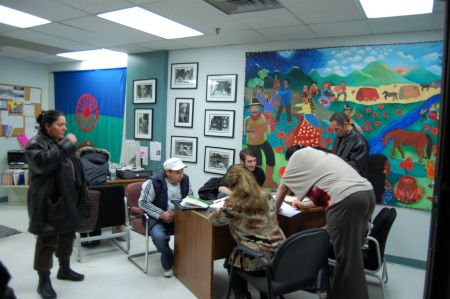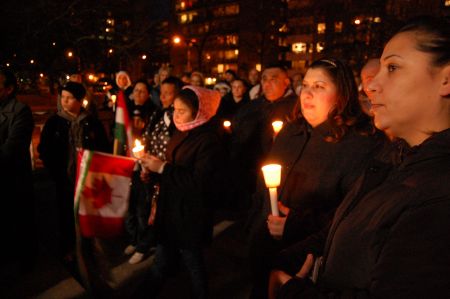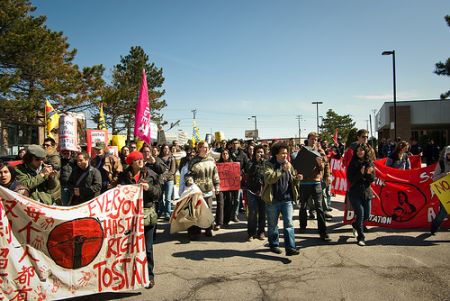TORONTO—The Toronto Roma Community Centre's one-room office, located on the ground floor of the Crossways Plaza in Toronto, has been operating in this location since October 2011. Founded in 1997 after the arrival of over 3,000 Czech Roma refugees in Canada, the RCC is the only organization for Roma operating in Toronto. Originally based out of the office of Culturelink, an immigrant settlement organization, the new space now hosts a number of different programs including a weekly English as a Second Language class, a women's support group and immigration counselling.
According to Gina Csanyi, Executive Director of the RCC, since acquiring the new office space there has been a dramatic rise in the number of people coming to the centre—around 20 per day—mostly Roma from Hungary. Csanyi said, “as things become progressively worse in Hungary more and more are fleeing.”
The Roma, more commonly known in the English-speaking world as Gypsies, are Europe’s largest minority with an estimated 8 to 12 million living in Europe, the majority in Central and Eastern Europe. Roma trace their roots back to northern India and are said to have left their home country and migrated west over 1,000 years ago. Throughout their long history in Europe they have been subjected to slavery, exiled, killed, used as scapegoats and have been historically marginalized in almost every country they have settled in. During the Second World War military officials sent the Roma living in Nazi-occupied countries en masse to concentration camps. Seven thousand Roma lived in the Czech Republic before the Second World War; less than 600 survived.
Today they suffer low employment rates, low education levels, lack of access to government services and health care, poverty, segregation and violent crimes perpetrated by neo-Nazis and skinheads. Forced school segregation programs and state removal of children affect Roma families in some jurisdictions.
Since 1997, thousands of Roma have been seeking asylum in Canada, the first wave coming from the Czech Republic, quickly followed by Roma from Hungary, and to a lesser degree Slovakia and Romania. Currently the largest group of Roma seeking asylum in Canada are from Hungary.
In recent years, changes to visa requirements and changes to immigration and refugee laws have created significant challenges to those wishing to immigrate here, leading to a massive decrease in the number of Roma accepted as refugees.
I met Robert and Monika, two volunteers, in the Roma Community Center on a Friday afternoon. They were helping organize the Hungarian Roma community.
According to Robert, a Hungarian Roma who came to Canada with his wife and child in 2010, one of the major problems in Hungary is that Roma are afraid to speak up about the persecution and discrimination they face because they have little support. Members of the police and government are intolerant of his people, he says. A far-right nationalist party that specifically targets Roma and Jews has grown into the third largest political party in the country and has spearheaded anti-Roma legislation. If Roma were to speak up, says Robert, they could lose their jobs and neo-Nazi groups would threaten them. The risk and insecurity prompted Robert and his family to flee the country. “I never want to go back,” he says. He and his family are waiting for their refugee court hearing to determine whether or not they can stay in Canada.
For many Hungarian Roma, applying for asylum in Canada is their last hope at finding a safe place to raise a family. Monika, another Hungarian Roma who came to Canada with her husband and 2 children said, “We had to sell everything to come here: our house, everything. We have no place to go if we return.”
According to Csanyi there are a number of obstacles the Hungarian Roma face when coming to Canada such as a lack of understanding of the rigorous process of the refugee system and what documents are expected for each refugee case such as police and medical records. It is often difficult for Roma to obtain these papers in their home countries because of police and state discrimination.
In Toronto, lawyers profiteering on the refugee claims of Hungarian Roma are also becoming an issue. “When I meet a client and see who their lawyer is I immediately know if they are going to have a successful claim or not,” says Csanyi. “These lawyers don’t even meet their clients. They cut and paste PIFF forms, have an almost zero acceptance rate, stretch out the case for years and once legal aid runs out they drop the clients.” This severely affects the chance of a successful outcome in the hearing.
The recent history of Roma immigration to Canada has been a complex one, which Csanyi and others say has been aggravated by immigration legislation such as Bill C-11 and the newly proposed Bill C-31.
The latest Roma immigration wave began in 1997, as rates of neo-Nazi attacks and discrimination in their home countries increased. At first the Immigration and Refugee Board largely granted the Roma refugee status based on the evidence of systematic and long-term persecution in the Czech Republic and Hungary. The acceptance rate for Hungarian Roma before 1998 was around 78%.
As the number of Hungarian Roma refugees increased in 1998, the Immigration and Refugee Board organized an unprecedented examination of the overall conditions in Hungary that would be used in deciding other Hungarian Roma refugee cases. This is the only time such an investigation, known as a “lead case,” has been carried out in the history of the IRB.
The lead case involved two families and the tribunal decided that the conditions in Hungary did not amount to persecution and denied the claimants refugee status. The result was that acceptance rates for Hungarian Roma dropped from 70 per cent to 8 per cent from 1998 to 1999.
On March 27, 2006, the lead case was overturned by the Federal Court of Appeal on the basis that it was designed solely to limit the number of Hungarian Roma accepted as refugees in Canada. From 1998 to 2006, more than 10,000 Hungarian Roma refugees were rejected and deported back to Hungary.
Newly appointed Immigration Minister Jason Kenney publicly vocalized the idea that refugee claims made by European citizens were illegitimate. Starting in 2008, the term “bogus refugee” became synonymous with refugees coming from so-called “democratic” countries. This had a strong impact on the outcome of refugee claims made by Roma coming from Eastern Europe. In 2008 the acceptance rate for Czech Roma was 94 per cent. After these public statements the acceptance rate plummeted to 10 per cent in 2010.
Soon after, the government established new visa requirements for Czech residents (as well as Mexican residents), drastically limiting them from coming to Canada and applying for refugee status.
Kenney's targeting of Roma refugees sparked legal action in the Roma community. Rocco Galati, a Toronto-based immigrant lawyer, and the Czech Roma community launched a lawsuit against Kenney accusing him of blatantly undermining the Immigration and Refugee Board's independent tribunal process by spreading bias against the Roma. Court action is ongoing.
Despite these difficulties, last year there were 4,423 new refugee claims in Canada made by Roma from Hungary, with 5,975 cases still pending. While Hungary is currently the country with the highest number of refugee claims made in Canada, its acceptance rates are one of the lowest. The 2011 acceptance rate of refugee claims from Hungary was 18.3 per cent compared to the national average of acceptance rates, which was 44.6 per cent. The average wait time for a hearing is three years, forcing many people to live in long-term uncertainty. Many point to immigration legislation and institutional bias against the Roma as the reason for these low acceptance rates.
The Balanced Refugee Reform Act (Bill C-11) was passed in 2010 under a minority Conservative Government. At the time of adoption, some of the more contentious parts of the legislation were removed in order to satisfy opposition party demands, only to resurface in the Conservative Government's latest immigration bill, C-31.
Kenney has said he hopes to see Bill C-31, named Protecting Canada’s Immigration System Act, passed by June 2012. Bill C-31 is an omnibus bill that incorporates aspects of several previously proposed pieces of legislation. The new laws would allow the detention of “irregular arrivals”—those who arrive by boat, for example—without a warrant or an appeal. It would also grant the Minister of Immigration sole authority to set a list of “safe countries,” which are deemed to be capable of protecting their citizens. This would limit the ability of residents of these countries to apply for refugee status and would revoke their option to appeal a rejection. They would also only be given 15 days to prepare and file their written statement which sets the basis of their claim, leaving little time to find legal counsel and translation.
Julianna Beaudoin, a PhD candidate at the University of Western Ontario, has been researching Roma and human rights issues since 2002, specifically focusing on the Canadian IRB and immigration policies. “Bill C-31 is yet another way the Canadian government is trying to reinforce the notion that there is a 'queue' for refugees, and groups like Roma who are taking active roles in trying to escape persecution and violence are 'jumping the queue,'” says Beaudoin. According to Beaudoin, Canada, as a signatory to the UN Convention on the Status of Refugees, has an obligation to provide Roma with a fair refugee hearing.
According to the government, assignment to the safe country list will only come after investigation, though there are questions as to whether other factors could be at play. Syed Hussan, an organizer with the immigrant and refugee rights organization No One is Illegal, argues that “safe country” legislation is linked to economic factors and trade agreements that Canada has signed or is negotiating. In particular, Canada is currently negotiating the Comprehensive Economic Trade Agreement (CETA) with the European Union. Hungary is a member of the EU and held its Council's presidency last year.
Critics question Canada's willingness and ability to accept refugees from countries with which it has signed trade agreements, since such economic affiliations often tacitly show support for a country's political system as well. Placing these countries on the “safe country” list gives the Canadian government the power to turn away large numbers of refugees. “We call this bill the Refugee Exclusion Act,” says Hussan. “This bill gives [immigration officers] massive powers of detention [of] anyone who is not a citizen and demolishes all the key pillars of a permanent refugee system. If citizenship can be taken away at the whim of a government we are in deep trouble.”



